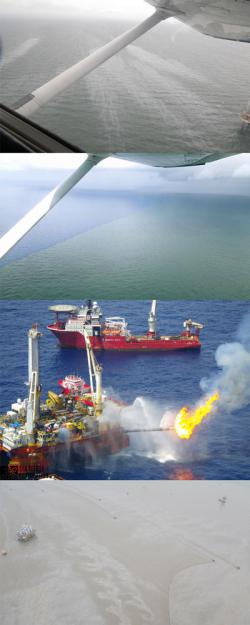An expert team was assembled today for a flyover of the Gulf oil spill: Dr. Wallace “J” Nichols, STRP Board member and acclaimed sea turtle biologist and activist; Bonny Schumaker, pilot for On Wings of Care and experienced Sea Sheppard activist; an agency expert on oil spill chemical physics who is conducting detailed studies; and myself, Sea Turtle Restoration Project marine biologist and toxicologist. We had to pack light for our flight onboard “Bessie”, the 1971 Cessna that has flown successful missions for wildlife conservation on both hemispheres of the globe. Thunderclouds lined the horizon, but we had confidence we could maneuver to safe skies and departed in the morning hours on our flight path to cover much of the Louisiana coast and out to “ground zero” of the spill.
Our goals were to document the sea turtle habitat destruction, spot any wildlife in and around the spill, locate areas of dense oil for agency studies, and share our observations with the world.
For almost an hour we cruised at 80-120 knots in Bessie over bayous, beaches and open ocean seeing only tar balls, small islands of reddish weathered oil, and some large, thin slicks. Our agency expert relayed information on estimated oil thickness and age based on the color and type of reflections the oil produced, and I took notes detailing conditions, wildlife sightings, and GPS coordinates of all interesting observations. We spotted a school of approximately 30 cow-nosed rays swimming at shallow depths. We flew over the Mississippi River Delta and the mouth of the river, seeing oil slicks and failed booms along established oil platforms and boats leaving Venice heading to the open ocean, and the massive convergence zone of fresh water laden with sediment colliding with the oiled sea water.
The entire crew was heartbroken and amazed to see a distinct line stretching to the horizon with blue ocean on one side, gray seas on the other and weathered oil along the convergence. We had been flying over sediment and oil-covered waters the entire morning, looking at oil slicks on top of a dirty, oiled ocean. Further studies are warranted to determine if the distinct blue to gray convergence was only due to oiled waters or if sea floor bathymetry or sediment loads were also contributing. Our agency expert and observations by the team placed us far from obvious sediment convergence seen along the Mississippi. The immensity of the sea turtle habitat destruction is difficult to describe in words. A significant portion of one of the most productive ocean ecosystems is coated in oil, and the foul weather is likely mixing the oil and dispersant emulsions deep into every trophic level of sea life.
Smoke on the horizon marked the location of the Deepwater Horizon explosion and the current oil recovery efforts. Over a dozen boats clustered around two floating rigs, one red rig on a square platform and one built into a vessel. Methane flares burned brightly from each rig, sending dramatic plumes of flames into the sky. Support boats sprayed liquids all over the scene, liquids that may have been seawater or dispersants. Bonny allowed us to open the windows to improve our chances at good photographs, and some of our results are stunning. The bad weather cleared temporarily, and to our amazement the ocean around the rigs was still blue. Even at hundreds of feet above the operations, the smell of petroleum inundated the airplane.
Our flight plan took us north to the remote wildlife refuge of the Chandeleur Islands. This island chain had been protected by thin strands of yellow and red oil booms, and most of these booms were now displaced. Hurricane Alex has wreaked havoc on the meager attempts to protect sensitive wildlife areas from the spill. Beaches were stained black and red as we flew high over the islands to ovoid contact with the thousands of sea birds below. Bonny knows this area very well now, having spent over 60 days in the Gulf performing flyovers to monitor the Gulf oil spill.
The final leg of the flight path was changed on the fly (no pun intended!) as real-time weather reports radioed to us allowed us to thread through narrow bands between massive thunderstorm clouds. Bessie bounced and weaved, and rain streaked across the windshield. Landing in high crosswinds was negotiated with skill by Bonny, and we were all extremely satisfied with the day’s observations.
No sea turtles were spotted from the air on water, in convergence zones, or on remote beaches. However, our team now has firsthand knowledge of the immense sea turtle habitat destruction present in the Gulf, which is growing every day. We will continue our efforts to provide transparent reports on Gulf conditions and activities in our effort to improve sea turtle rescue and rehabilitation from oil exposure, and habitat protections for future generations of sea turtles in the Gulf of Mexico.




